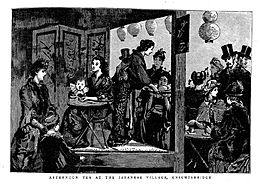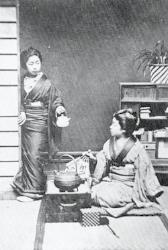Japanese Village, Knightsbridge facts for kids


The Japanese Village was a special exhibition in Knightsbridge, London. It showed off Japanese culture during the late Victorian era, which was a time when Queen Victoria ruled Britain. This village was open from January 1885 to June 1887. It was set up inside a building called Humphreys' Hall. About 100 Japanese men and women worked there, making the place look and feel like a real Japanese village.
Contents
About the Japanese Village Exhibition
This exhibition was a business idea created by Tannaker Buhicrosan (1839–1894). He had already organized other Japanese shows in Britain for several years. In the 1850s, Japan started trading more with Britain. This led to a big interest in everything Japanese in Britain during the 1860s and 1870s. Many British people thought of Japan as a very old-fashioned, traditional country.
This idea was very popular, especially with people who liked the Aesthetic movement. This movement focused on beauty in art and life. Because of this, the Japanese Village was a huge hit! More than 250,000 people visited it in its first few months.
What You Could See and Do
The exhibition was built to look just like a traditional Japanese village. It was all set up inside Humphreys' Hall. Around 100 Japanese men and women lived and worked there. They even had separate sleeping areas.
Advertisements for the village said that skilled Japanese artists and workers would show off their country's ways. They would wear their national costumes. Visitors could see a beautifully decorated Buddhist temple. You could also enjoy five o'clock tea in a Japanese tea-house. There were Japanese music shows and other fun events. The idea was to show "Every-day Life as in Japan."
The Village and The Mikado
While Gilbert and Sullivan were writing their famous opera The Mikado in 1885, one of the writers, W. S. Gilbert, visited the village. He even hired some Japanese people from the village. They helped teach the actors in his play how to act like Japanese people.
A Fire and a Rebuild
In May 1885, Humphreys' Hall sadly burned down overnight. One person working at the village died in the fire. However, Mr. Buhicrosan quickly announced that they would rebuild the hall and the exhibition as fast as possible.
The Japanese workers had already agreed to visit Berlin for another exhibition. So, they went to Berlin first. Meanwhile, the hall and the village were rebuilt. The exhibition re-opened to the public in December 1885. The new village had "several streets of shops," "two temples and various free-standing idols," and "a pool with a rustic bridge."
The exhibition stayed open for another year and a half. By February 1887, over a million people had visited it! The Japanese Village finally closed in June 1887.
Images for kids





